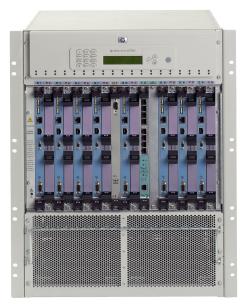HP launches bold open-standards based “blade server” initiative
Dec 4, 2001 — by LinuxDevices Staff — from the LinuxDevices Archive — viewsHP unveiled a bold new initiative in the web server market today, with the announcement of a CompactPCI and Linux based blade server product line (see press release excerpt, below).
The term blade server refers to single-card computers that are housed within an open chassis (see photos). Rather than developing a proprietary approach — as has been done by rivals Compaq, Sun, IBM, and Dell — HP based its new blade server product line on a combination of existing open standards: CompactPCI along with several Linux implementations (with other OSes to follow).
The introduction marks something of a milestone for CompactPCI, an “industrially hardened” version of the desktop PC's PCI bus. According to Brian Cox, product line manager for HP's new blade server family, this is the first case of a major electronics manufacturer employing CompactPCI in an application which primarily targets enterprise computing. CompactPCI is typically used in applications that demand — and can afford — a very high degree of ruggedness and reliability, such as industrial control, telecommunications switches, and medical instrumentation.
Cox says the CompactPCI approach offers a 2:1 density advantage over traditional 1U rackmount servers. Other benefits include “great improvements over 1U servers in areas such as ease of cabling, serviceability, and manageability.”



Left: Front and rear of blade servers
Right: Blade server chassis with multiple blade servers installed
To be successful with the new CompactPCI-based blade server architecture, HP is going to have to overcome some tough challenges. One problem is that CompactPCI is notoriously expensive, generally being reserved for high-end applications where ruggedness and reliability are more critical than cost.
Secondly, HP has announced plans to support a range of operating systems including several flavors of Linux (Debian, Red Hat, and SuSE), initially, followed by HP-UX and Windows NT. However, CompactPCI is not as straightforward as the desktop PC, having many implementation-specific variations, so HP will have its hands full supporting an entire family of new computer boards across a range of operating systems.
Additionally, the reliability-conscious customers who are willing to pay the higher costs associated with CompactPCI will expect full support for the “High Availability” (HA) capabilities of CompactPCI, including such features as “hot swap”, multiprocessing, failover, and backplane messaging.
On the other hand, industry analyst IDC projects that the blade server market will grow to nearly $3B over the next several years (see release, below), so the potential payback is significant.
Here is an excerpt from HP's press release announcing the new blade server product line . . .
HP Ushers In Future of Web Access Computing with Blade Servers
Standards Support, Alliance Program Accelerate Technology Adoption
Palo Alto, CA — (press release excerpt) — Hewlett-Packard Company (HP) today launched the industry's first blade server product series based on open industry standards. The series enables enterprises, telecommunications companies and service providers to streamline Internet data center management by adding flexible, efficient, easy-to-manage server capacity and Internet functionality in a highly compact unit.
HP also announced a blade server alliance program to help accelerate the delivery of compatible products that use the same CompactPCI industry standard used in HP blade servers. The program helps both hardware and software providers to develop, test and market their blades products and give customers more computing options.
More than 20 companies have already endorsed the HP blade server and its open standards-based architecture, including Agilent Technologies, AMD, Amphus, Brocade, Diversified Technology, Inc., Ensim, F5 Networks, Force Computers, GDA Technologies, InfoValue, Inktomi, Intel, PolyServe, Radisys, RealNetworks, Savastra Systems, SBS Technologies, ServerWorks, SonicWall, Transmeta, and TurboLinux.
HP's blade server products are essentially “computers on a board” operating in a compact chassis that reduces complex wiring issues. The products include server, storage, appliance, network, switch and management blades and are supported by HP OpenView service manageability tools which include comprehensive network, system, storage, application and service management solutions. HP blade server products will initially run on the Linux operating system distributions of Red Hat, Debian and SuSE. HP-UX and Microsoft Windows are expected to be available on the blade server in the first half of 2002.
With this blade server product series, HP aims to seize the leadership position in the rapidly expanding blades market, which IDC estimates will reach $2.9 billion by 2005. IDC also estimates that by 2005, the blade unit design will have captured approximately 23 percent of entry-level server unit sales and 10 percent of entry-level server revenue.
The third-party alliance program, known as the “HP Blade Server Alliance”, will expand customer choice and adoption by accelerating third-party blade solution development in support of HP's open standard blade product series. The program is open to all types of software and hardware vendors. The HP Blade Server Alliance program will provide product interoperability assurance with testing certification programs, which are expected to be available in 2002. More information, including a listing of participating companies and information on how new companies can join the program, is available at HP's Developer and Solution Partner Portal.
The HP blade server chassis, server blade, storage blade, network blade and management blade are currently available for order. The estimated U.S. retail price starts at $1,925 for a single server blade or $7,525 for an HP blade server chassis with one management blade.
This article was originally published on LinuxDevices.com and has been donated to the open source community by QuinStreet Inc. Please visit LinuxToday.com for up-to-date news and articles about Linux and open source.